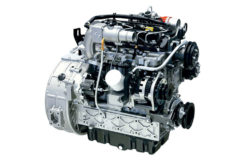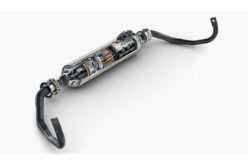David Street, Director – Marketing & Business Development, ANSYS Inc

Overview
-
Conclusion:
In today's world, if anyone picks any existing product and integrates intelligence into it, it will have more adaptability compared to the normal one in the long run. Therefore, it's a good opportunity for Indian companies, if they could build intelligence in mechanical products they could be world leaders of tomorrow.
Please tell us something about ANSYS?
If you look at the history, ANSYS started off by simulating a particular physics domain. We started as a structural analysis company and once we got the command over it, we moved into fluid dynamics, electromagnetics, multiphysics. With all that and huge domain knowledge along with decades of experience backed by skilled manpower we became world leader in simulation technology.
At ANSYS, we bring clarity and insight to customers’ most complex design challenges through fast, accurate and reliable simulation. Our technology enables organizations to predict with confidence that their products will thrive in the real world. They trust our software to help ensure product integrity and drive business success through innovation.
What are the current trends in the industry?
The trend that we are beginning to see is how individual companies use those individual (structure, fluid, electromagnetic) simulations to change the way they develop any product. It’s not about just using simulation, it’s about how a company uses simulation. It’s not about being just good at CFD or just at FEA, but it’s about how you look at the design process. How you change the design process and utilize simulation. The only way you could do that is by having the right capability of simulation technology, expertise and resident talent. We are observing a trend where in a single platform of each of these products (CFD, FEI) can communicate with each other.
Now that we have acquired some technology and invested in integrated technology we are seeing how to create design flows that utilize all kinds of ANSYS products. That way you can begin to recognize how it will benefit the market is not just to think about simulation as an analysis & design tool but much about how simulation drives product development. We have seen that the use of simulation is more in developed market like Asia. Japan leads when it comes to using simulation and we are witnessing the same in Korea. This trend is making its way through China and India too. In countries like India and China a lot more basic adoption of simulation is yet to happen. We can say that we are in a commanding position as we have products for the entire spectrum.
Integrating intelligence in mechanical products is another trend that we are observing. In today’s world, if anyone picks any existing product and integrates intelligence into it, it will have more adaptability compared to the normal one in the long run. Let’s take an example of air conditioner; if air conditioner can continuously sense number of people and their location in the room and can adjust the temperature accordingly it will be in high demand in future. To integrate some kind of intelligence you will need electronics and for that you will need simulation. Therefore, it’s a good opportunity for Indian companies, if they could build intelligence in mechanical products they could be world leaders of tomorrow.
How long do you think it will take for India to adopt simulation technology?
This is like a pyramid so on top you see companies who are growing, providing good solutions and competing on the world stage. Top companies are very aggressive investing in technology from companies like ANSYS. And as you come down in the pyramid the adoption and awareness level changes. It is just a matter of time, but I see India holds huge opportunities.
Which is the most promising sector for ANSYS in India and what are the other emerging sectors?
Talking about India, automotive, aerospace, electronics and academic has been the growth driver. These are the four main industries for us. Also projections suggest that India is going to import huge amount of electronics equipment in 10 years from now. So, there will be huge demand in this sector even if India produces small part of it in the country. These are areas which are all about physics electromagnetics, structural, fluid dynamics and countries like Korea, Japan, Taiwan are very mature in this. India needs to develop its electronics industry, because now the mechanical components are integrating electronics into it. Another industry for ANSYS is heavy industry, turbo machinery and automotive among others.
What is your strategy to penetrate the SMEs?
Simulation is not affordable for many small and medium companies. When these companies invest they are very much conscious about the ROI as its huge investment for them. In such cases we show them how this technology can help them grow. There are SMEs who believe that “we can’t afford not having this technology, it’s very essential for our business”. They are seeing simulation as means of reducing cost. The perception that you have to be big company to adopt simulation is wrong. It’s a resourceful technology and will pay back significantly. Also, the software is easy to use and the cost is not as much as it used to be.
To spread awareness about this technology, we have taken several initiatives along with some plans for the near future. Our engineers are always there to help customers learn and understand the technology. To educate our customers we hand hold them from the beginning. We advise them which simulation technology is best suited for their production process and when is it appropriate to go the next level of simulation. So we don’t just go to customer and say “hey buy our products” we help them gradually adopt simulation so that they can become more competent.
ANSYS was listed in “Software 500 list” for the 8th consecutive year. How have you managed it year after year?
There are number of reasons for the same, we are focused, we have a vision and strategy that has helped us till now. Many companies change their offerings and strategy, but we were focused and know what we are doing. We want to make simulation part of every engineer’s portfolio. We are always ahead in adopting and investing in technology. We acquired technologies before anyone could think of it, for example Fluent. Fluent was best-in-class and if you look at the acquisition that we made of Ansoft, they are excellent in what they do.
Tell us something about your R&D efforts?
We spend about 17.4% of our overall revenue for the research activities. It’s significantly high for companies like ours and it is growing continuously. Two years ago it used to be 15%, but we have increased it now. Apart from this, since we are a software development company a sizable amount of knowledgeable people are working with us in the R&D department.
You have a fairly large team in India, how Indian team is helping ANSYS Inc grow?
Yes, it’s largest after our headquarter in the USA. I would say that we made the right decision to invest in India because the amount of skilled manpower we have here in India, that too from some of the premier institutes helps us a lot in new developments. India team is directly involved in new product development activities.
Simulation technology has been there for a long time, any new developments that you have observed?
If you look at different physics, for example the mechanical area, the focus will always be on improving capability in new analysis and building better capability in modelling of composite materials. In the area of fluid dynamics, reacting flow, particularly for automotive combustion will continue to improve. Another trend is that to be able to integrate all of those physics (structure, fluid, electromagnetic). So for example, you can check the data from fluid flow analysis and transfer it to structural analysis. In today’s world, you can’t just rely on magnetic simulation, or just flow simulation, you need to build all of these otherwise you will not be able to check the performance of your products.
Factors that sets ANSYS apart from its competitors?
There are many companies who offer individual physics. What makes us unique is our ability to be able to conduct multiple physics. Our product offering caters to many industries sets us apart from our competitors. The other thing is our people. I know everyone says we invest in our people, but for us it’s very important. We have best-in-class application experts in our company. With our huge experience in simulation and presence in many countries we can offer cumulative expertise. The third and the most important factor is that the customers are confident that we are financially stable; they know that we are not going to disappear tomorrow. It’s very important in our industry because when big companies make an investment in simulation they want to know the stability of the company too.
Your future plans for the Indian market?
As a company we want to make sure that we are covering more of the market. It’s not just big companies, small and medium companies are also gearing up for simulation so we want to support them in their growth. We will continue to be their growth partner.
By Nishant Kashyap










